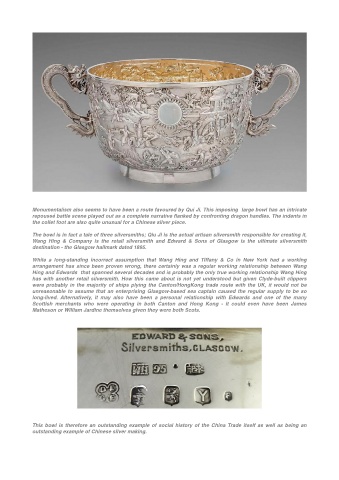Page 610 - Chinese SIlver By Adrien Von Ferscht
P. 610
Monumentalism also seems to have been a route favoured by Qui Ji. This imposing large bowl has an intricate
repoussé battle scene played out as a complete narrative flanked by confronting dragon handles. The indents in
the collet foot are also quite unusual for a Chinese silver piece.
The bowl is in fact a tale of three silversmiths; Qiu Ji is the actual artisan silversmith responsible for creating it,
Wang Hing & Company is the retail silversmith and Edward & Sons of Glasgow is the ultimate silversmith
destination - the Glasgow hallmark dated 1895.
While a long-standing incorrect assumption that Wang Hing and Tiffany & Co in New York had a working
arrangement has since been proven wrong, there certainly was a regular working relationship between Wang
Hing and Edwards that spanned several decades and is probably the only true working relationship Wang Hing
has with another retail silversmith. How this came about is not yet understood but given Clyde-built clippers
were probably in the majority of ships plying the Canton/HongKong trade route with the UK, it would not be
unreasonable to assume that an enterprising Glasgow-based sea captain caused the regular supply to be so
long-lived. Alternatively, it may also have been a personal relationship with Edwards and one of the many
Scottish merchants who were operating in both Canton and Hong Kong - it could even have been James
Matheson or William Jardine themselves given they were both Scots.
This bowl is therefore an outstanding example of social history of the China Trade itself as well as being an
outstanding example of Chinese silver making.

